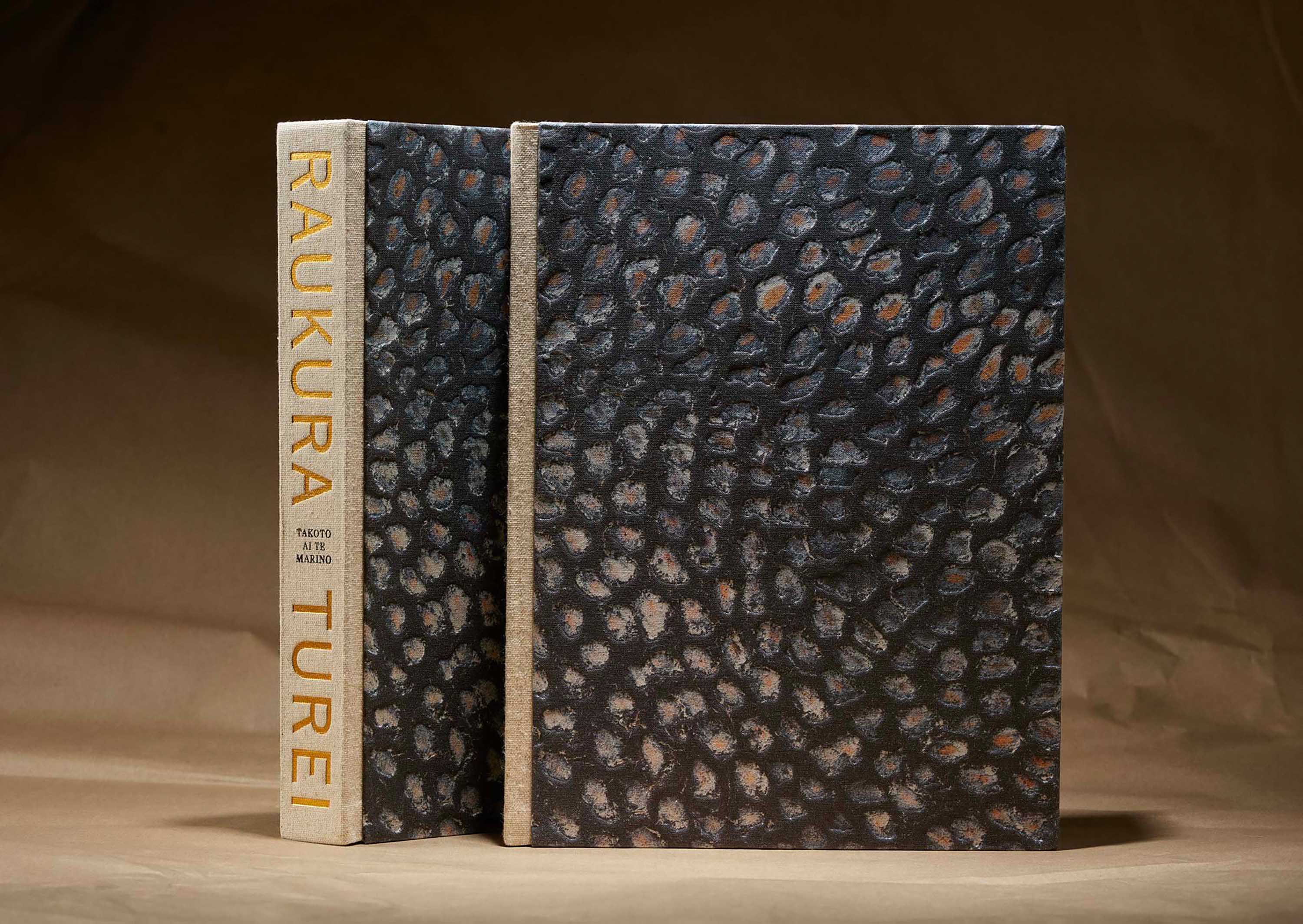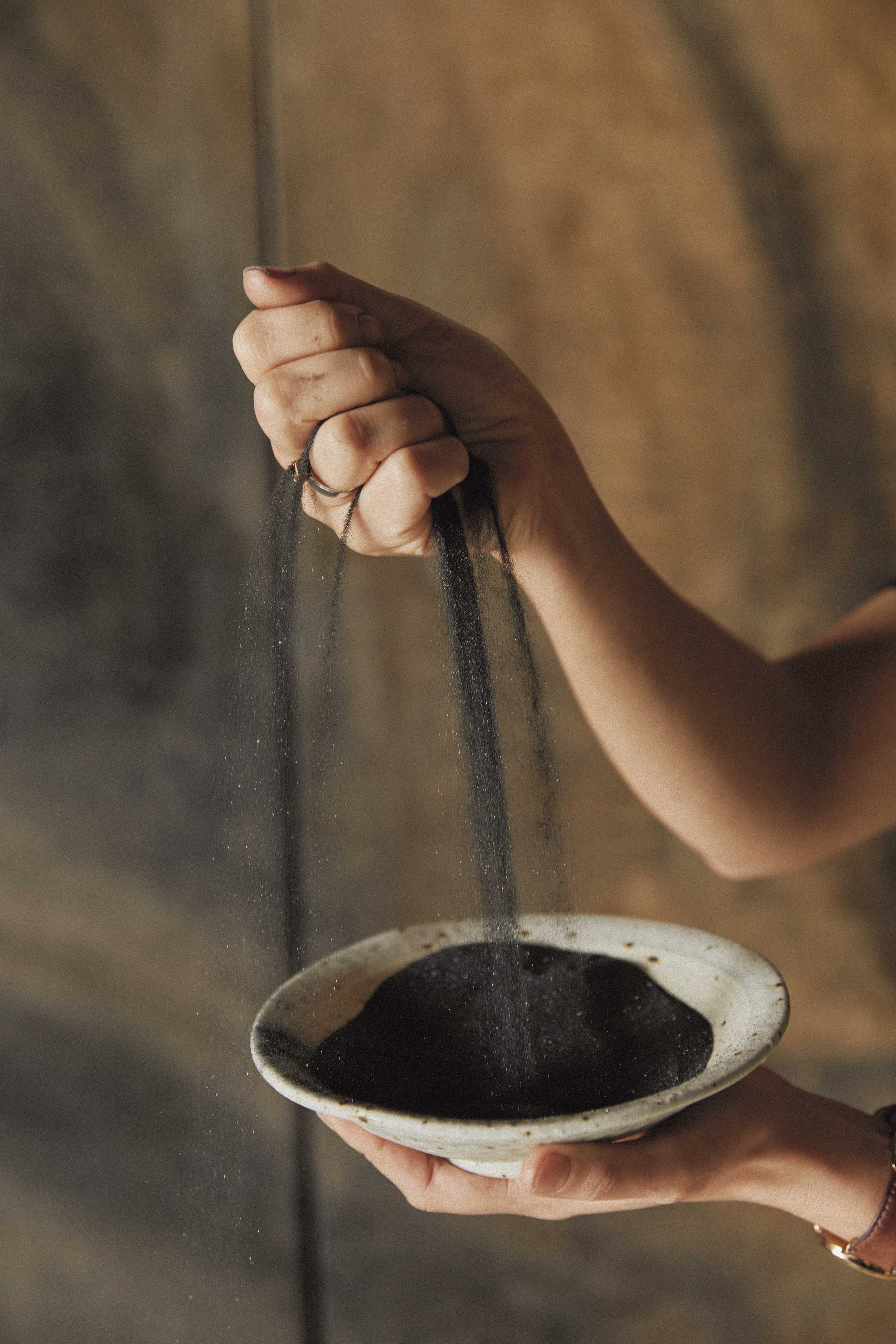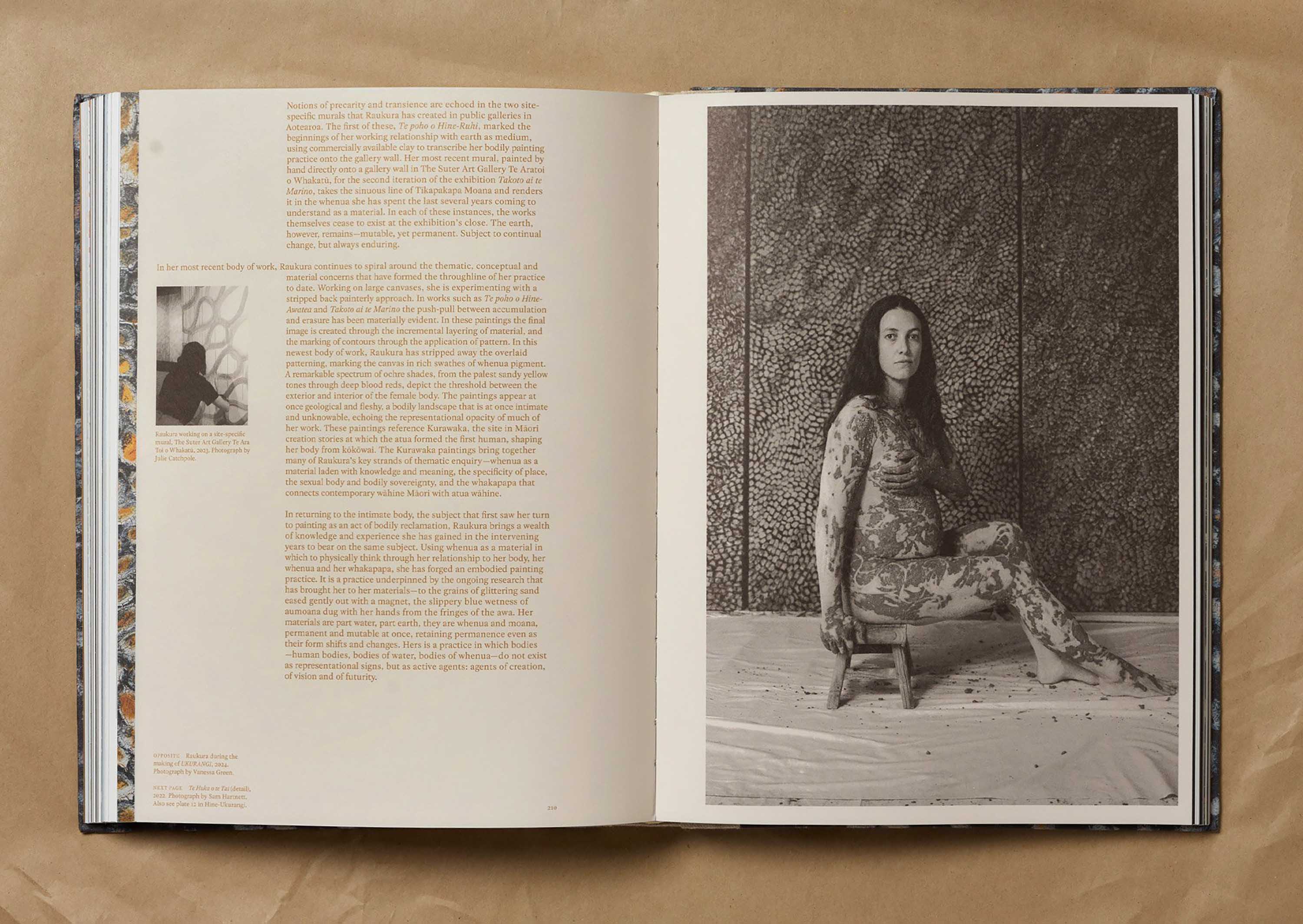


Artist Raukura Turei (Ngā Rauru Kītahi, Taranaki, Ngāti Pāoa, Ngāi Tai ki Tāmaki) never knew her grandmother, Dorothy: she died before she was born, and before her father Pita was able to reconnect with her after being separated from her as a child. That wound – along with others, including the loss of their ancestral whenua beside Tīkapa Moana – are a running theme through her work, which seeks to connect to her whenua and her whakapapa “one bucket at a time”.
To do that, she’s been working with whenua as a medium since 2018, sourcing the very particular types of sand and earth from coastlines around Tāmaki Makaurau. Now, she’s released an extraordinarily beautiful book, Takoto ai te Marino, produced by Studio Katie Kerr, complete with academic notes, poems – and “anecdotes on gathering”, of which this is one.
Onepū
Growing up, our whānau would spend a lot of time on the West Coast, despite living in central Tāmaki Makaurau. Going to Te Henga for birthdays, or the bush for a hīkoi seemed like the normal way to spend our weekends or holidays, but as Mum would put it, we didn’t have a lot of money when we were kids, so it was our whānau’s happy place. All the plants around Mum’s small section on Grey Lynn Park were sourced from the Waitākere Ranges, saplings dug out from the side of the road on the drive home. The ngahere and moana were our silent teachers. While it may have felt arduous being made to recount the names of different rākau or manu, I’m not mad about it now.
From a young age we knew that Dad’s mum, Nana Dorothy, had drowned fishing off the rocks at Te Henga. Although her tinana was brought back to shore with the line around her neck, the image of Hine-Moana carrying her out to sea on her bosom is one I’ve etched into my subconscious. Dad had never reconnected with her again after he was made a ward of the state as a toddler. Once he had found out he was ‘definitely a Māori’, he went looking for her, door knocking from one end of Don Buck Road to the other, and got pretty damn close, but didn’t reach her in time. We still want to change her headstone at Waikumete to include Dad’s name.
An early memory of our summers on the coast of Piha and Te Henga was having to sprint with bare feet from the dunes down to the water’s edge to escape the burns underfoot. I remember that sand as being black-black, with fine blue veins. It has been fascinating returning to these places with the intent of gathering and noticing how much the colour of the sand has changed. Now Te Henga is very ash-brown, awash with white sands that at one stage I had presumed had drifted down the coast from Te Oneroa-a-Tōhē, Ninety Mile Beach. The migration of sand on the West Coast, however, heads north, much like bodies found by surf lifesavers that wash up on the next beach over, up the coast. This is also the path spirits take, journeying north to Te Rerenga Wairua. Perhaps Nana knew the fastest route to Rarohenga was from the West.
The sand dunes at Pōrae, a now-mythical headland on the tip of the Āwhitu Peninsula, have shifted north to Whatipu over the last hundred years. Less mythical are the tonnes of black sand mined on the coast south of Kāwhia, and sent to China and Japan on one of our largest export ships, the Taharoa Destiny. Only for very special pieces will I use magnets to extract the fine blue iron sands from Te Henga that gather into creature-like forms at each end. The deep cracks in the rock formations where taniwha reside have often been markers of iron rich onepū on gathering trips. Returning with my kōtiro to explore the caves of Kaiwhare has also revealed some of the bluest deposits seen yet seen along the coast since my childhood. Everything in the land is always shifting.
Every time I visit this coastline I have a mixed agenda of wanting to bathe in Hine-Moana, feel her charge, and also scan the shoreline for iron sands. For the piece Te poho o Hine-Moana, I took Mum, my sister Mihitai and a very young Hinauri to Whatipu, where we used to spend holidays in the old homestead of the Whatipu Lodge. I have vivid memories of the expanse of black sand that stretches up the coastline as far as the eye can see. It’s a treacherous beach for swimming, so we would bathe in the pools where the Whatipu stream meets Paratutae Island. I still have a streak of black sand in my thigh from where the skin cut deep on a shell and healed over the grains. Black sand is heavy, even more so when wet, and it is a long walk back to the car park carrying full buckets in each hand.
A generation earlier, Dad remembers wading up the Henderson Creek as a youngster. It was a popular swimming hole where he learnt to swim, and the paru would build up on his thighs leaving a near-shimmering blue residue. While I wouldn’t dream of swimming in this awa today, I think of how Parawhenuamea carries these memories as layers pressed into her banks.
During a Turei whānau wānanga at Objectspace sitting alongside Te poho o Hine-Moana, we heard stories of our nana by my aunty Robyn Pitcher and cousin Deanne Douglas, many for the first time. We then took the kōrero out West to Waikumete and sang waiata by her grave, another first for our whānau. She was definitely with us that day. Aunty Robyn mentioned how Dorothy was referred to by her whānau back East as ‘the funny one’. Layers of abuse could definitely make you behave in ways that even your own whānau would like to erase from memory or record. Knowing that histories play out from one whare tangata to the next was a drive for me to lean in and push through, rather than ‘let sleeping dogs lie’. Not just for my own kōtiro, but all the wāhine in our whānau.
Tēnei te mihi ki ngā uri o Te Kawerau ā Maki, nō koutou te mana ki tēnei whenua ki Te Wao nui ā Tiriwa tae noa atu ki Te Tai-o-Rehua.


Onepū
Ko te Tai Hauāuru o Tāmaki Makaurau te āhuru mōwai o tōku whānau nōku e tipu ake ana, ahakoa i te pokapū o te tāone kē tō mātau kāinga noho. He mea māori noa te haere ki Te Henga mō ngā huritau, te hīkoi rānei i te puihi i ngā wā whakatā. Ki tā tōku whaea, ahakoa te pōhara ā-pūtea nei i tō mātau tamarikitanga, i whai rawa kē mātau i ngā wheako o te taiao. Katoa ngā tipu māori kei te pito whenua iti o taku māmā i Grey Lynn i takea mai i Te Wao nui ā Tiriwa. He kōhuri i karia ake i ngā tahataha o te rori i te hokinga ki te kāinga. Ko te ngahere me te moana ō mātau tino pouako. Ahakoa taku hōhā i te whakahaua o mātau kia tākina ngā ingoa o ngā uri o Tāne, he tino hoa haere ēnei akoranga ināianei.
Mai anō i taku kōhungahungatanga, i mōhio au i riro tōku kuia, a Nana Dorothy, i te ngau a Hinemoana, i a ia e hī ika ana i Te Henga. Ahakoa i pae tōna tinana ki uta, ko te aho e herea ana ki tōna kakī, kua tāia ki taku hirikapo ko te ata o Hinemoana e kawe atu ana i taku kuia ki tawhiti mā runga i tōna uma. Kīhai a Pāpā i piri anō ki taku kuia whai muri i tana wehenga i tōna ūkaipō, me tana noho hei tamaiti taurima nā te Karauna. Ka pā te māramatanga he uri Māori ia, mai i te tāhaetanga o tana kōpaki nā te Tari Toko i te Ora, ka tahuri ia ki te kimi i tōna whaea. Tīmata mai ana i tētahi pito o Don Buck Road, ka pātōtō kūaha haere ai tae rā anō ki tērā atu pito. Ahakoa te tata, auare ake tā rāua tūtataki anō i mua atu i te matenga o tōku kuia. E hiahia tonu ana te whānau kia whakatikaina te kōhatu whakamahara mōna, kia whai wāhi atu ai te ingoa o Pāpā.
He hokinga mahara ki ngā raumati ki te tāhuna ki Piha me Te Henga, ko te haere kotahi atu i ngā tāhuahua ki te takutai, kia kore ai e wera ō mātau waewae. Ki a au nei he pōuriuri te pango o te oneone o taua wā, me ngā ia kahurangi e whita mai ana. I taku hokinga ki ēnei takiwā kohikohi onepū ai, kua kite au i te rerekē o ngā tae o te tāhuna. Kua reia te onepū o Te Henga ki ngā kirikiri tea nei, me taku pōhēhē i tere mai i Te Oneroa-a-Tōhē. Heoi, ko ngā onepū i te Tai Hauāuru ka tere whakateraki, pērā i ngā tūpāpaku ka pae ki uta, he mea kite nā te hunga kauhauora ki te tāhuna. Koinei hoki te ara ka whāia e ngā wairua ki te raki, ki Te Rerenga Wairua. I mōhio hoki pea tōku kuia ka tōtika tana haere ki Rarohenga i te Tai Hauāuru.
I ngā rā o mua tū ai ngā tāhuahua o Pōrae ki te kūrei o Āwhitu. I ngā rau tau kua tere whakateraki ēnei onepū ki Whatipu, whakawhitia ana ko te pūwaha o Te Mānukanuka o Hoturoa. I ngā tau tata nei e hia kē ngā tana onepū kua hukea i te tāhuna ki te tonga o Kāwhia, kua tukua atu ki Haina me Hapani mā runga i tētahi o ngā kaipuke kawekawe kaitā katoa, i te Taharoa Destiny. I āku nei mahi toi, hei ngā wā hirahira anake whakamahia ai ngā autō ki te whakawehe i ngā onepū kahurangi o Te Henga mai i ngā kirikiri tea nei; ānō nei he kīrehe te hanga o te one ki ia pito. Kei ngā tomo o ngā taniwha te kura huna o te onepū tino kahurangi nei te whēriko. I a au e hōpara ana i ngā ana o Kaiwhare me aku kōtiro i ngā marama tata nei, i tūhuratia ai he onepū kahurangi, he momo tē kitea nō mai anō i taku tamarikitanga. He mea nekeneke mutunga kore te whenua.
Ia wā ka hoki au ki te Tai-o-Rehua, ka hiahia ahau ki te kaukau, kia purea ai ki ngā wai ora o Hine-Moana, kia rangona ai tōna kaha, ka hiahia hoki ki te kohi onepū i te takutai. I a au e whakarite ana i Te poho o Hine-Moana, i kawe au i a Māmā rātau ko taku teina, ko Mihitai, ko taku kōhine, ko Hinauri ki Whatipu ki te kohi onepū. He wāhi motuhake tēnei ki tōku whānau, i te mea i a au e tamariki ana i noho mātau ki te Rōti o Whatipu hārarei ai. Mārama kehokeho ana taku mahara ki te tāhuna pango e toro atu ana i te ara o Hine-Tuakirikiri tae atu ki te pae tawhiti. Me i kore ake ngā puna wai e hono ana i te manga o Whatipu ki te motu o Paratutae, ka kore mātau e kauhoe, he mōrearea nō te moana i konei. He rārangi onepū e mau tonu ana ki tōku hūhā mai i te wā i motukia taku kiri ki tētahi anga koi. He taumaha te onepū pango, ka mutu, ka taumaha noa atu ki te mākū, ā, he roa te hoki mā raro ki te taunga waka, he ipu kīkī i te one kei ia ringa.
Hoki ana ki te whakatipuranga o tōku pāpā, ka maharatia tana kautū i te Wai-ō-Pareira i tana tamarikitanga, ā, kitea ana te paru e piri ana ki ōna hūhā, me he unaunahi kahurangi. I taua wā he puna rongonui i reira mō te hunga tamariki, ā, ki reira ako ai ia ki te kauhoe. Ahakoa kua tāhawahawatia ngā wai i te awa rā i ēnei rā, ka tahuri aku whakaaro ki a Parawhenuamea e kawe ana i ngā mahara o te onamata ki ōna tahatika.
I whakarāmemene ētahi o tō mātau whānau Turei ki ngā rekereke o Te Poho o Hine-Moana i a ia e iri ana ki Objectspace, ki te whakawhiti kōrero e pā ana ki tō mātau kuia. I tuku kōrero taku whaea kēkē, a Robyn Pitcher, rāua ko taku kaihana, ko Deanne Douglas—ko te nuinga i rangona e au mō te wā tuatahi. Whai muri ake, i rere tonu ngā kōrero ki Waikumete, ki reira mātau waiata tahi ai ki te takotoranga whakamutunga o tō mātau kuia. He tuatahitanga anō tēnei mō te whānau. I rongo pai mātau i tōna wairua e piri mai ana i taua rā. I mea mai a Aunty Robyn, nā te whānau o Hauraki a Dorothy i tapa ki te ingoa whakaparahako, ‘the funny one’. He mea tāmi wairua te whakamanioro, me te aha, ka hua i konei he whanonga kāhore tonu tō whānau ake e hiahia kia maharatia. Ki taku mōhio ka tukuna ihotia ngā nawe o mua i tētahi whare tangata ki tētahi, nō reira ka tahuri au ki te whai i te pono, hāunga te hiahia o ētahi whanaunga kia waiho aua kōrero kia moe noa. Mō aku kōhine, mō ngā wāhine katoa hoki o tōku whānau te take.
Tēnei te mihi ki ngā uri o Te Kawerau ā Maki, nō koutou te mana ki tēnei whenua ki Te Wao nui ā Tiriwa tae noa atu ki Te Tai-o-Rehua.
Takoto ai te Marino
Raukura Turei
Studio Katie Kerr

%2C%202022_CMYK.jpg)
Related Stories: